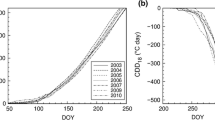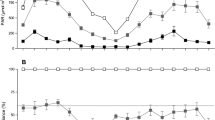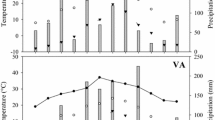Abstract
Gross photosynthesis and respiration rates of leaves at different canopy heights in a Rhizophora stylosa Griff. stand were measured monthly over 1 year at Manko Wetland, Okinawa Island, Japan, which is the northern limit of its distribution. The light-saturated net photosynthesis rate for the leaves at the top of the canopy showed a maximum value of 17 μmol CO2 m−2 s−1 in warm season and a minimum value of 6 μmol CO2 m−2 s−1 in cold season. The light-saturated gross photosynthesis and dark respiration rates of the leaves existing at the top of the canopy were 2−7 times and 3–16 times, respectively, those of leaves at the bottom of the canopy throughout the year. The light compensation point of leaves showed maximum and minimum peaks in warm season and cold season, respectively. The annual canopy gross photosynthesis, foliage respiration, and surplus production were estimated as 117, 49, and 68 t CO2 ha−1 year−1, respectively. The energy efficiency of the annual canopy gross photosynthesis was 2.5%. The gross primary production GPP fell near the regression curve of GPP on the product of leaf area index and warmth index, the regression curve which was established for forests in the Western Pacific with humid climates.






Similar content being viewed by others
References
Alongi DM, Tirendi F, Clough BF (2000) Below-ground decomposition of organic matter in forests of the mangroves Rhizophora stylosa and Avicennia marina along the arid coast of western Australia. Aquat Bot 68:97–122
Andrews TJ, Muller GJ (1985) Photosynthetic gas exchange of the mangrove, Rhizophora stylosa, in its natural environment. Oecologia 65:449–455
Ball MC, Critchley C (1982) Photosynthetic responses to irradiance by the grey mangrove, Avicennia marina, grown in different regions. Plant Physiol 70:1101–1106
Clough BF (1992) Primary productivity and growth of mangrove forests. In: Robertson AI, Alongi DM (eds) Tropical mangrove ecosystems. American Geophysical Union, Washington, DC, USA, pp 225–249
Clough BF (1998) Mangrove forest productivity and biomass accumulation in Hinchinbrook Channel, Australia. Mangroves Salt Marshes 2:191–198
Clough BF, Sim RG (1989) Changes in gas exchange characteristics and water use efficiency of mangroves in response to salinity and vapor pressure deficit. Oecologia 79:38–44
Clough BF, Ong JE, Gong WK (1997) Estimating leaf area index and photosynthetic production in canopies of the mangrove Rhizophora apiculata. Mar Ecol Prog Ser 159:285–292
Ewel KC, Twilley RR, Ong JE (1998) Different kinds of mangrove forests provide different goods and services. Global Ecol Biogeogr Lett 7:83–94
Farnsworth EJ, Ellison AM (1996) Sun-shade adaptability of the red mangrove, Rhizophora mangle (Rhizophoraceae): changes through ontogeny at several levels of biological organization. Am J Bot 83:1131–1143
Hagihara A, Hozumi K (1977a) Studies on photosynthetic production and its seasonal change in a Chamaecyparis obtusa plantation. J Jpn For Soc 59:327–337
Hagihara A, Hozumi K (1977b) Estimation of foliage respiration and its seasonal change in a Chamaecyparis obtusa plantation. J Jpn For Soc 59:405–413
Hagihara A, Hozumi K (1983) Studies on primary production in a Chamaecyparis obtusa plantation. J Jpn For Soc 65:357–365
Hozumi K, Kirita H (1970) Estimation of the rate of total photosynthesis in forest canopies. Bot Mag Tokyo 83:144–151
Hozumi K, Kirita H, Nishioka M (1972) Estimation of canopy photosynthesis and its seasonal change in a warm–temperate evergreen oak forest at Minamata (Japan). Photosynthetica 6:158–168
Hozumi K, Nishioka M, Nagano M, Kirita H (1973) Estimatioin of total photosynthetic production by a forest canopy. Proceedings of the East Asian Regional Seminar for the IBP, 30 January–1 February 1973, Kyoto, Japan, pp 45–56
Kajimoto T (1995) Ecological characterstics of Pinus pumira (in Japanese with English summary). Jpn J Ecol 45:57–72
Khan MNI, Suwa R, Hagihara A, Ogawa K (2004) Interception of photosynthetic photon flux density in a mangrove stand of Kandelia candel (L.) Druce. J For Res 9:205–210
Khan MNI, Suwa R, Hagihara A (2005) Allometric relationships for estimating the aboveground phytomass and leaf area of mangrove Kandelia candel (L.) Druce trees in the Manko Wetland, Okinawa Island, Japan. Trees 19:266–272
Kira T (ed) (1976) Rikujyou Seitaikei (in Japanese). Kyouritu Shuppan, Tokyo, Japan, 166 pp
Kira T (1991) Forest ecosystems of East and Southeast Asia in a global perspective. Ecol Res 6:185–200
Kira T, Yabuki K (1978) Primary production rates in the Minamata forest. In: Kira T, Ono Y, Hosokawa T (eds) Production in a warm-temperate evergreen oak forests of Japan. University of Tokyo Press, Tokyo, Japan, pp 131–145
Kurachi N, Hagihara A, Hozumi K (1993) Canopy photosynthetic production in a Japanese larch forest. II. Estimation of the canopy photosynthetic production. Ecol Res 8:349–361
Kuroiwa S (1966) Dry matter production by plants (in Japanese). In: Gendai no Seibitsugaku, vol 9. Iwanami Shoten Publishers, Tokyo, Japan, pp 71–100
Lambers H (1985) Respiration in intact plants and tissues: its regulation and dependence on environmental factors, metabolism and invaded organisms. In: Douce R, Day DA (eds) Higher plant cell respiration. Springer-Verlag, Berlin, Germany, pp 418–473
Larcher W (ed) (2001) Ökophysiologie der Pflanzen, 2nd edn. Verlag Eugen Ulmer Gm bH & Co, Stuttgart, Germany, 408 pp
Ledermann TC, Tett P (1981) Problems in modelling the photosynthesis—light relationship for phytoplankton. Bot Mar 24:125–134
Li MS, Lee SY (1997) Mangroves of China: a brief review. For Ecol Manage 96:241–259
Lieth H (1968) The measurement of calorific values of biological material and the determination of ecological efficiency. In: Eckardt EE (ed) Functioning of terrestrial ecosystems at the primary production level. UNESCO, Paris, pp 233–242
Maruyama K (1971) Effect of altitude on dry matter production of primeval Japanese beech forest communities in the Naeba Mountains. Mem Fac Agric Niigata Univ 9:86–171
Maruyama K, Yamada S, Nakazawa M (1968a) Altitude and primary productivity (in Japanese). J Jpn For Soc 79:288–291
Maruyama K, Yamada S, Nakazawa M (1968b) Estimation of photosynthetic production in a natural forest of Fagus crenata (in Japanese). Trans Mtg Jpn For Soc 79:286–288
Monsi M, Saeki T (1953) Über den Lichtfaktor in den Pflanzengesellschaften und seine Bedeutung für die Stoffproduktion (in German). Jpn J Bot 14:22–52
Mooney HA, Gulmon SL (1982) Constraints on leaf structure and function in reference to herbivory. Bioscience 32:198–206
Nakasuga T (1979) Analysis of the mangrove stand (in Japanese with English summary). Bull Coll Agric Univ Ryukyus 26:413–519
Nakasuga T (2002) Stand structure of mangrove forest in the Manko estuary, Naha, Okinawa (in Japanese with English summary). In: A Comprehensive Study on Mangroves in Okinawa Islands, 2002. RIS, Okinawa, Japan, pp 211–220
Nishioka M, Hozumi K, Kirita H, Nagano M (1978) Estimation of canopy photosynthesis and respiration. In: Kira T, Ono Y, Hosokawa T (eds) Biological production in a warm-temperate evergreen oak forest of Japan. University of Tokyo Press, Tokyo, Japan, pp 99–111, 142–143
Saeki T (1960) Interrelationships between leaf area, light distribution and total photosynthesis in a plant community. Bot Mag Tokyo 73:55–63
Saenger P (ed) (2002) Mangrove ecology, silviculture and conservation. Kluwer Academic Publishers, Dordrecht, The Netherlands, 360 pp
Suwa R, Khan MNI, Hagihara A (2006) Canopy photosynthesis, canopy respiration and surplus production in a subtropical mangrove Kandelia candel forest, Okinawa Island, Japan. Mar Ecol Prog Ser 320:131–139
Tamiya H (1951) Some theoretical notes on the kinetics of algal growth. Bot Mag Tokyo 64:167–173
Acknowledgements
We thank Dr. M. N. I. Khan, Mr. S. M. Feroz, and Mr. K. Analuddin for their participation in fieldwork. This study was partially supported by Grant-in-Aid for Scientific Research (nos. 16201009 and 16651009) from the Ministry of Education, Culture, Sports, Science and Technology, Japan, and the 21st Century COE program of the University of the Ryukyus.
Author information
Authors and Affiliations
Corresponding author
Rights and permissions
About this article
Cite this article
Suwa, R., Hagihara, A. Seasonal changes in canopy photosynthesis and foliage respiration in a Rhizophora stylosa stand at the northern limit of its natural distribution. Wetlands Ecol Manage 16, 313–321 (2008). https://doi.org/10.1007/s11273-007-9066-2
Received:
Accepted:
Published:
Issue Date:
DOI: https://doi.org/10.1007/s11273-007-9066-2




